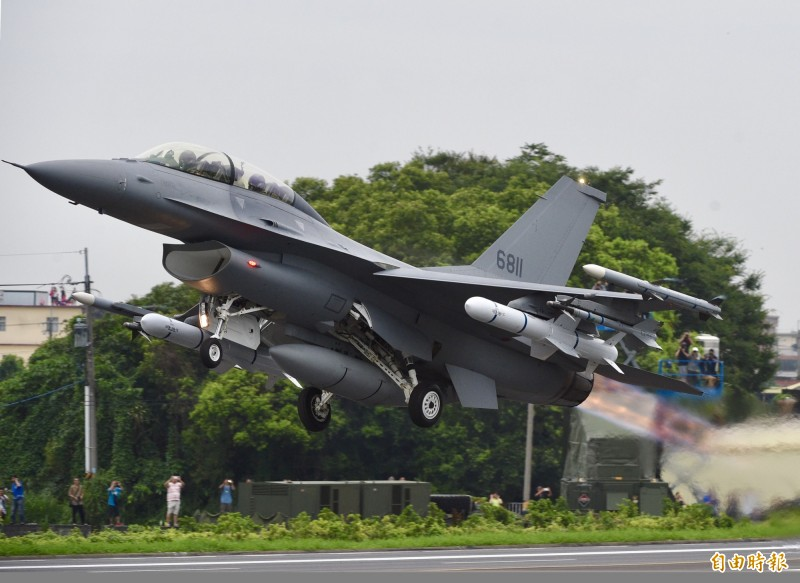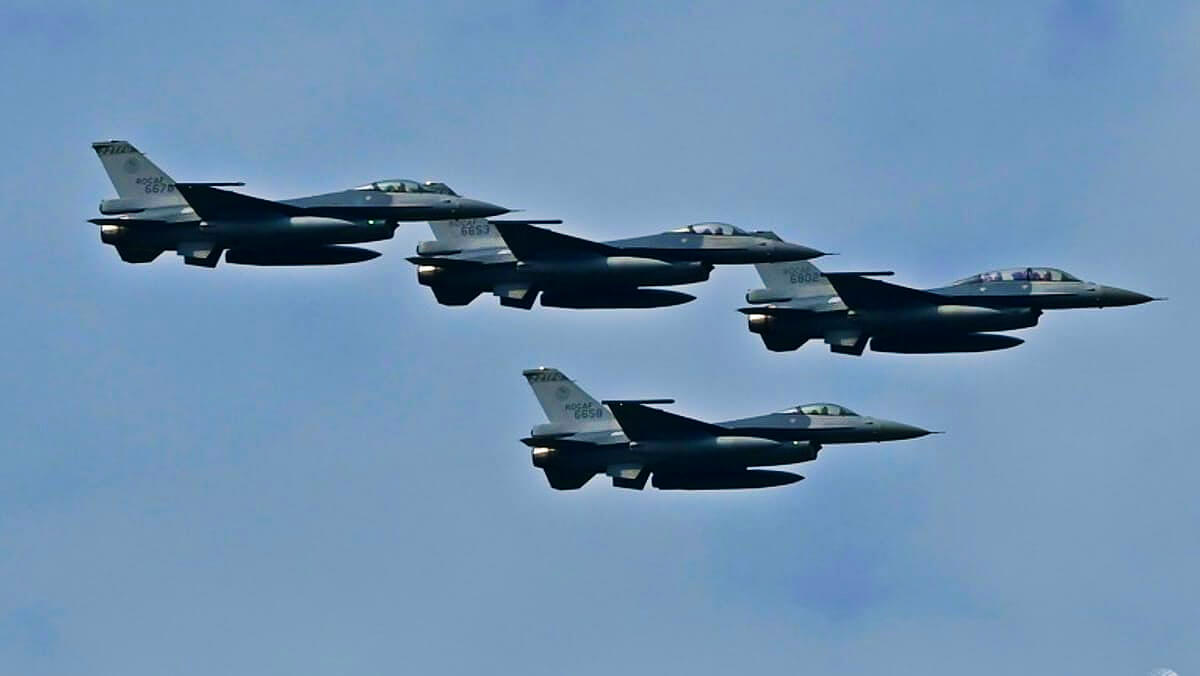As the Chinese military conducts military drills around Taiwan, the self-governing island appears to be preparing for any potential attack by outfitting its four F-16V (Vipers) with lethal weapons, including Harpoon missiles, to defend the country’s east coast, reported Liberty Times.
Following Nancy Pelosi’s visit to Taiwan, the People’s Liberation Army of China announced sharp military drills in six regions bordering Taiwan and entering its territorial waters.
Since then, Chinese military aircraft and warships have been conducting drills near the Taiwan Strait, and many of them are still active in the eastern seas.
Taiwan’s Hualien Air Force Base is reportedly ready to scramble its four fully loaded F-16V fighters, each outfitted with two air-launched anti-ship harpoon missiles, to defend the nation’s east coast.
4 fully loaded ??F16Vs scramble to counter intruding ??PLAN vessels. Each F16V carries 1 ALQ184 electronic warfare pod, 2 AGM84 Harpoon AShMs, 2 AIM120 AMRAAMs, 2 AIM9 Sidewinders, 2 wing fuel tanks.??https://t.co/D0L5ZGvaPJ
— Taiwan Military (@TaiwanMilitary) August 6, 2022
There has been a lot of activity at the Air Force’s Hualien Base recently. According to the report, general training tasks have all been stopped and transitioned to combat readiness tasks.
The base has prepared more than ten combat readiness mission aircraft, most of which are equipped with short-range sidewinder missiles and AIM-120 advanced medium-range missiles.
Four are F-16Vs, each equipped with two AIM-120 advanced medium-range missiles, two short-range sidewinder missiles, two air-launched AGM-84 harpoon missiles, and an ALQ-184 electric warfare capsule, and two auxiliary fuel tanks under the mid-abdomen.

Upon receiving the order, these aircraft can immediately take to the air and launch a direct attack on the warships of the PLA Navy.
The Ministry of National Defense emphasized that the country’s military has employed various surveillance and investigation methods to watch the entire process to avoid escalating the situation constantly. The ministry stated they wished to uphold the principle of preparing for war and not seeking war.
China-Taiwan Clash: Taipei Adopts ‘Porcupine Strategy’ That Aims To Make Chinese Invasion ‘Bloody Costly’ With US Support
US Deploys F-22 Raptors Within ‘Striking Distance’ From Russia; 1st Forward Deployment Since Ukraine War
The Air Force officers, who appeared to be confident in their abilities, claimed that they could sink China’s ships with absolute certainty as long as the Ministry of National Defense gave them the order, adding that “one is not enough, then two, one is not enough, then another, until it sinks!”
The Harpoon (RGM-84/UGM-84/AGM-84) is a subsonic anti-ship cruise missile developed in the United States and has been used since 1977. Since its inception, various variants have been developed, including air, ship, and sub-launched versions.

The Harpoon has also been upgraded several times to improve its range and guidance. The missile has also been modified for use on various aircraft, including the P-3 Orion, A-6 Intruder, S-3 Viking, AV-8B Harrier II, F/A-18 Hornet, and US Air Force B-52H bombers, F-16s.
Variants of this missile have been exported to nearly 30 countries, including Taiwan, Pakistan, Japan, Singapore, South Korea, the United Arab Emirates, and the majority of NATO countries.
Taiwan’s Frigate Shadows PLA Navy’s Warship?
Images of a Taiwanese Navy Cheng Kung-class frigate purportedly following a China PLA Navy Type 052C destroyer (hull number 150) in the southwest waters of Kao-hsiung Harbor are going viral on the internet.
The incident, according to reports, happened at 8 am on August 5. The country’s Naval Command made no comment on the matter, but neither confirmed nor denied it.
It only stated that naval warships’ joint intelligence, surveillance, and reconnaissance mechanisms could efficiently comprehend the dynamics of ships in the Taiwan Strait.
This morning, 8am, PLAN Type 052C destroyer Changchun (front) and a ROCN frigate of the Cheng-Kung class faced off near Kaohsiung. pic.twitter.com/VBd1fazSU6
— Lia Wong (@LiaWongOSINT) August 5, 2022
Meanwhile, Taiwan’s defense ministry stated on August 4 that it would take the necessary steps to defend Taiwan’s airspace and territory. Just before August 4, two F-16 sorties carrying live missiles departed from Hualien Air Base.
Another F-16 with live missiles was seen near an air base in Chiayi and a Black Hawk helicopter on a training mission.
The Cheng Kung class are guided-missile frigates currently serving in the Republic of China (Taiwan) Navy (ROCN). They were produced by China Shipbuilding Corporation in Kaohsiung, Taiwan, under license, during the 1990s, as a component of the Kuang Hua I project. They are centered on the US Oliver Hazard Perry class.
Before the Taiwanese Navy acquired the Keelung (Kidd)-class destroyers in 2005, these frigates were the ROCN’s theater air defense. The frigates are 453 feet long (138 meters), 46.95 feet wide (14.31 meters), and have a displacement of 4,103 long tons (4,169 t) when fully loaded. Their top speed is 29 knots or 54 km/h.
The SPS-49(V)5 air-to-air search radar, which operates in the C/D band and has a maximum search range of 460 kilometers, is the primary air-to-air detection system of the Cheng Kung class. This radar has a peak power of 360 kW and an average power of 13 kW.
The ship’s MK92 Mod.6 launch control system, which uses STIR-240 for guidance, can launch up to 6 rounds per minute. For air defense, it can also employ the MK15 square array, 40mm/L70 fast gun, and MK75 Type 76 fast gun.
- Contact the author at ashishmichel@gmail.com
- Follow EurAsian Times on Google News




